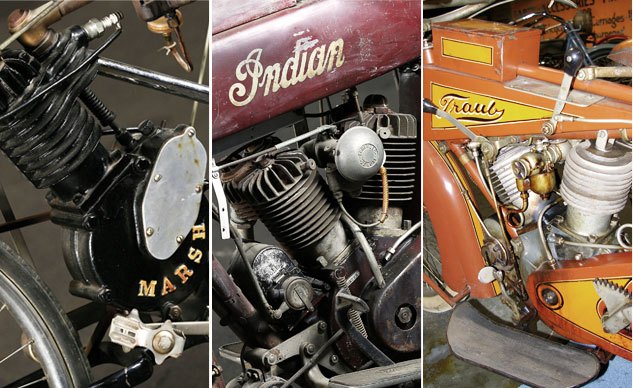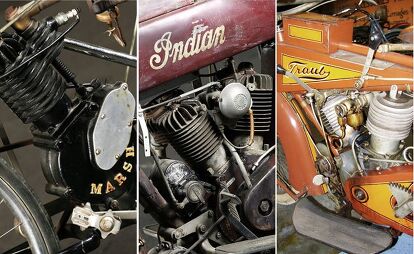Discovering Dragon's Teeth
A trio of ultra-rare American survivor bikes
By the early 1900s, some 300 different U.S. motorcycle manufacturers had jumped on the bandwagon of two-wheeled powered flight. While some tried steam or electricity, it was the internal combustion engine that got things burbling.
Henry Ford and his mass assembly lines managed to turn the tide toward four wheels, resulting in the subsequent fading into the history books of 99% of those early ironhorses. But a century later a few of those limited-run machines still managed to survive, not swallowed up by the two World Wars hungry for scrap metal or crumpled on some race track.
The History Of Four-Cylinder Motorcycle Engines In America
Following are three “survivors” that stayed the course, and through luck and often the passion of a human caretaker, still can get their cylinders a thumpin’ and our hearts a-pumpin’. Their original price tags couldn’t today pay for even one of their footpegs, but they’re great dreamcatchers for your bucket list.
A Bend in Time – Marsh Motor Cycle
Just the thing when you play Motorcycle Trivial Pursuit, here’s one in the category of common as dragon’s teeth. An American milestone motorcycle, the Marsh (1900-1913) was among the first purpose-built motorcycles rather than simply a bicycle fitted with a motor. In 1902, Brockton, Mass. brothers W.T. and A.R. Marsh improved their initial 1899 design by relocating the engine, previously mounted forward of the seat post and now an integrated member of the frame. One giant leap forward for motorcycling.
The 510cc IOE (inlet over exhaust) Single produced 3 to 3.5 horsepower and was capable of propelling the belt-driven 150-lb. machine to a then-blistering 40 mph. The unusual 90-degree exhaust design helped keep heat from frying the rider’s leg, while the “tool box” shaped underslung fuel tank held 1.5 gallons, a second tank mounted behind the seat carrying another half gallon.
While Indian is credited with setting things off in the U.S. in 1901, it initially employed 152 motors sourced under contract with The Aurora Machine and Tool Co. (later branching off with the Thor Moto Cycle Company). Credit as a “first” may go to the Marsh brothers who were utilizing engines of their own design. Today the original Marsh Singles, produced at the very beginning of motorcycle production, are exceptionally rare. In fact, this is thought to be the only one in existence.
According to the report, on May 30, 1904, during a hill-climb contest staged at nearby Fort George, Mass., a Marsh was the fastest of all entries. Furthermore, the ad went on to offer a host of prizes to the Marsh agent selling the most 1904 machines, oddly enough the first prize being a “20 H.P. Touring Car with bevel gear drive, two speeds and reverse … value $1650.” The fourth-place winner got something special indeed: “A Special Marsh Motor Cycle, finished in the most lavish manner, having every part nickel plated, and with tandem attachment … value $200.”
Charles H. Metz had added his input to the evolution of the motorcycle when in 1893 he founded the Waltham Manufacturing Co. (a spin-off of the Waltham Watch Company), first building bicycles then launching into various forms of motorcycles and automobiles. In fact Metz is credited with being the first to coin the term “motor cycle,” which first appeared in print via an 1899 advertisement, even if his vehicle was closer to a car than a bike since it carried four passengers and was convertible from four to three wheels.
Metz would go on to build two-wheeled machines under the Orient badge that would earn him a special page in the history books. He first introduced his two-wheeled creation to the world in July 1900, at the Charles River Race Track in Boston, considered the first recorded motorcycle speed event in the United States.
After the Waltham Company was sold, Metz teamed up with Marsh in 1905, to establish the American Motorcycle Company in Brockton, Mass., where they briefly produced the Marsh-Metz, also known as M-M, and then launching a 1000cc V-Twin in 1906.
By 1908 Metz was mostly making cars, the company progressively falling on hard times. In 1923, Metz closed shop, bundled his family into his last production car and drove cross-country to Glendale, California, where he opened a cabinetry business, passing away on June 29, 1937.
1918 Indian Model N Powerplus
Please do not call this a rat bike. In reality it shows the patina of remarkable originality, as in “barn find.” This 97-year old Indian represents some 18 years of innovation by George Hendee and Oscar Hedstrom after the two icons of motorcycling first signed the company’s founding contract in 1900 on the back of a paper envelope, after which they set out to design a “popular motorbike.” This machine helped fulfill that goal.
Of the two founders of the Indian Motocycle Manufacturing Company (and yes, the correct spelling is “Motocycle”), it was Hendee who came up with the name Indian, and in 1904 also chose the now famous red and gold color scheme. From their single-cylinder models, the world’s first to feature twist-grip controls for both throttle and ignition, Indian then debuted its new V-Twin in 1907.
In response to Indian’s 1-2-3 win at the 1911 Isle of Man TT, the first ever victory for a “foreign” machine at the British event, the Springfield, Mass., factory went from producing some 20,000 machines annually to 60,000 by 1914, their bikes sold through more than 2,000 worldwide dealerships.
It was Indian’s chief designer, Charlie Gustafson, who in 1916 came up with the 986cc side-valve engine. To establish its prowess, Indian sent Cannonball Baker to Australia where he established a world record of 1027 miles in 24 hours on a Powerplus. The first women to travel coast to coast in the U.S. were sisters Adeline and Augusta Van Buren, both on the Powerplus. In 1917 and the U.S. entry into WWI, most of the entire production of the machines “joined” the army.
The side 42-degree, 61-cu.-in. V-Twin produced 7 hp with speeds of up to 60 mph and beyond. This bike features a generator and thus electric, rather than acetylene, powered lighting for both headlamp and taillight. Very original, it even retains its frame-mounted bicycle pump.
Currently in the collection of Preston Evans, it is rightly revered for its milestone connection to Indian. In its present condition, this nearly 100-year old survivor is a virtual time machine that deserves to be preserved as such.
The 1916 Traub: Motorcycling’s Greatest Mystery
Unless this bike was created in an alternate universe that one day we might explore, it remains a total mystery. You can see it, touch it and smell it at Dale Walksler’s wonderful Wheels Through Time Museum. What is known about can be summed up in just a few words.
It was discovered in 1967, concealed behind a brick wall of a residence in Chicago. Its maker is unknown. All of its parts, excluding the seat, carb and magneto, are apparently hand-built. None of the parts is interchangeable with the components of any other early machine.
Its engine displaces 80 cubic inches and features massive 2-inch valves. The 3-speed transmission is a unique design with two neutrals plus two ways to operate the clutch. While there’s no front brake, the rear unit is also unique as it’s a double-acting design. Front suspension is an elliptical spring design, There are not one but three tool compartments. Walksler says the bike is in perfect operating condition and performs flawlessly to speeds in excess of 80 mph.
More by Paul Garson














































































Comments
Join the conversation
I wish I was good enough at CAD to reverse engineer these old engines.
3d printing and backyard casting are at a level now that even Jewels Verne couldn't imagine, and it would be really cool to see high school kids building Bloodymarrys out of
Aluminum cans Corrugated roofing and scrap lam-beams.
Out of the Box thinkers are always
fascinated by these bikes of yore that were produced before
one-mindedness took over. The many different ways their designers
solved the same mechanical problems lends inspiration to modern
mechanics. The knowledge that can be gained at Dale Walksler's museum
is more than one can absorb in one lifetime. It's a must see
especially on a day when he has the time to fire up the old bikes.